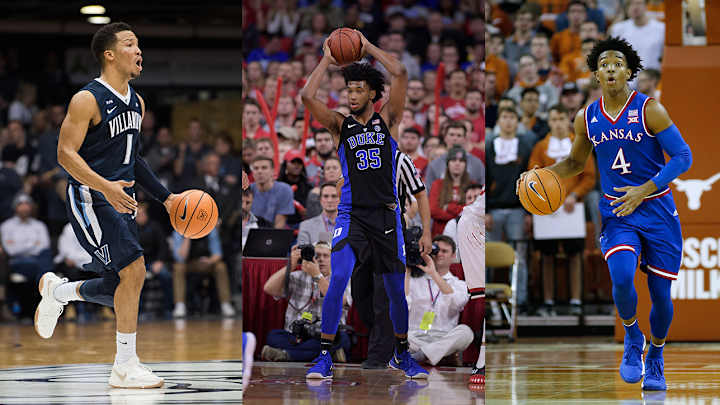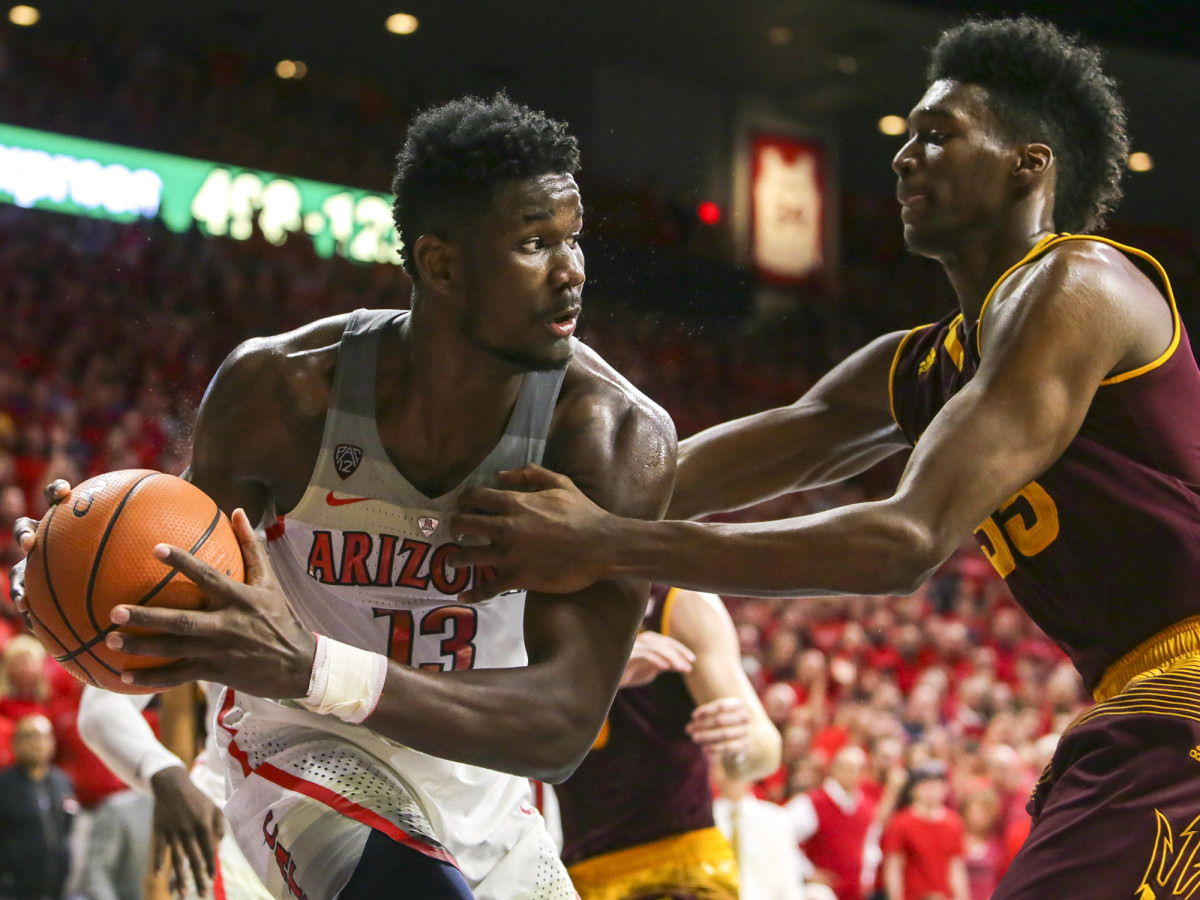Four Candidates Who Can Challenge Trae Young for the 2018 Player of the Year Award

Any argument about college basketball’s player of the year should begin and end with Trae Young. He has far outpaced the field through this point of the season, and that holds true even when you factor in his two previous games, at West Virginia and against Texas Tech, neither of which met the exceedingly high standard he set during nonconference play despite yielding a combined 56 points and 14 assists. Young’s transcendence has drowned out other individual feats of brilliance around the country, but they shouldn’t be ignored altogether. Come March, the NPOY discussion could be more expansive than the Young-dominated one that fits the state of play, provided he doesn’t open up an even bigger lead between now and then. Below are four other candidates who deserve to be recognized for what they’ve done so far.
This is the seventh version of a weekly column analyzing four college hoops topics bound by some underlying narrative thread. If there’s something you’d like to see in this space, don’t hesitate to reach out to me.
DeAndre Ayton, Arizona
The gulf between college value and pro potential that often characterizes elite basketball prospects does not apply to Ayton. He showed up in Tucson rated No. 3 in the class of 2017 Recruiting Services Consensus Index, a composite that incorporates data from a number of services, and is widely regarded as a potential top-five pick in the 2018 NBA draft. Whatever his ceiling as a pro, Ayton is clearly a very, very good college player. This truth has not been in question at any point this season, not even during Arizona’s worrying skid at the Battle 4 Atlantis during Feast Week, in which Ayton poured in 66 points on 23 of 37 shooting and snatched 37 rebounds over three consecutive losses to North Carolina State, Southern Methodist and Purdue. Nor was Ayton at fault during the Wildcats’ first defeat since that slide in the Bahamas, a three-point decision at Colorado on Saturday in which he scored a game-high 26 points on 11-of-17 shooting. There is very little an opponent can do to slow down a nimble, 7’1”, 260-pound center with a 7’5” wingspan who can bully defenders for easy inside finishes and step away from the basket to drain jump shots. Ayton scores efficiently at a high volume, and he’s helped hold together Arizona’s uncharacteristically shaky defense by pulling down 30% of missed shots while he’s on the floor, the eighth highest percentage in Division I, according to kenpom.com.

By the way, Ayton is on the floor quite a bit for someone his size: Thanks in part to a low foul rate, he’s logging more minutes per game than all but one teammate. Even with the defeat in Boulder on Arizona’s ledger (and coach Sean Miller’s concerning comments over the weekend about not being able to “reach” his players), the Wildcats don’t appear to have many credible challengers in the Pac-12, especially after Ayton posted a 23-and-19 double-double to help them take down in-state rival Arizona State at the McKale Center a day before New Year’s Eve. He’ll have to contend with late tipoff times and the widespread unavailability of Pac-12 Networks in vying for national attention, but Ayton won’t be neglected if he keeps producing like this.
Devonte’ Graham, Kansas
Graham opened his senior campaign facing the rather large burden of filling the featured scorer/playmaker shoes left behind by 2017’s NPOY, point guard Frank Mason III. He’s acquitted himself well so far, despite the wave of skepticism about the sustainability of Kansas’s Big 12 title streak inspired by a loss to Texas Tech at Allen Fieldhouse earlier this month. As coach Bill Self continues to forge ahead with a thin forward corps, he’s leaned even more heavily on a perimeter group headed by Graham, whose usage percentage during conference play has risen to 27.4 during his 38.5 minutes per game. Compared to his second-fiddle run as a junior last season, Graham is getting to the free throw line more often and converting at a higher clip once there, connecting on his three-point attempts at a more favorable rate and recording more steals on a per-40 minute basis, including the key swipe he delivered on TCU guard Alex Robinson with just over two minutes left in Fort Worth on Saturday. Graham proceeded to sink eight free throws to close out a four-point road win that could well be the difference between the Jayhawks hanging their 14th consecutive Big 12 banner and having their streak end in a tie with UCLA’s run from 1967-1979. During a win over Iowa State on Tuesday, he put up an ugly 4-for-14 shooting line, but his nine assists, four steals and trio of buckets during clutch time helped Kansas cinch game that was closer than it should have been. Whether or not the Jayhawks fortify their frontcourt by adding freshmen Silvio De Sousa and Billy Preston at some point, the Big 12’s depth of quality demands that Graham maintain the form he’s displayed over the first 16 games of the season in order for Kansas to pass the Bruins. He’s more of an upside play than the three other names highlighted here: If Graham guides the short-handed Jayhawks to the top of the most challenging conference in the country, it’ll be tough to knock his candidacy. Over the course of a long Big 12 season filled with tight clashes between evenly matched teams, Graham is a superlative individual performer who can separate Kansas from the rest of the pack.
Jalen Brunson, Villanova
Brunson has elevated his game every season since arriving in Philadelphia as a five-star recruit in the class of 2015. After helping push a veteran-heavy team to a national championship while sharing a backcourt with a more high-profile senior (Ryan Arcidiacono) in 2016, Brunson took well to an increased offensive workload the next year by scoring more efficiently and committing fewer turnovers. He’s spent this season building a convincing case that he’s the best player in the country at his position. Brunson is hitting a higher percentage of his shots from both sides of the three-point arc than he did as a sophomore, attempting more free throws on a per-40 minute basis, assisting on a higher percentage of his teammate’s baskets while he’s on the court and giving the ball away far less frequently. As much justified praise as Young has garnered for his ridiculous offensive outbursts this season, Brunson is submitting his own superlative volume-efficiency combination, albeit one that, unlike Young’s, tilts more toward the latter than the former.
Since the 2009-10 season, Brunson is the only qualifying high-major guard who has posted an Offensive Rating of at least 135 with a usage percentage 23 or higher, according to sports-reference.com. Young has a much fuller offensive plate than Brunson this season, with a usage percentage of 38.1 compared to Brunson’s 24.6, but Young’s 125 ORtg can’t hold a candle to Brunson’s 144.8. One of Brunson’s teammates, 6’7” junior Mikal Bridges, belongs in the NPOY discussion, too (and is far more esteemed as a draft prospect), but consider what happens to Villanova’s offense when Brunson takes to the bench: The Wildcats score 1.07 points per possession, compared to 1.31 when he’s in the game, according to data from hooplens.com. With Brunson burying about half of his 3s and 65% of his 2s and ranking seventh in the country in assist-to-turnover ratio, Villanova has cemented its status as the favorite to claim a fifth consecutive Big East regular season title and looks on track to book a ticket for a seat on the No. 1-seed line in the near future.
Marvin Bagley III, Duke
The Blue Devils will enter Wednesday night’s game at Pittsburgh having dropped two of their first three ACC games, and those two losses came against teams picked to finish 12th (North Carolina State) and 14th (Boston College) in the conference’s preseason media poll. In spite of its nation-leading offense, Duke is going to have a really hard time making good on its Final Four potential unless it tightens the screws defensively, a la the 2014-15 Blue Devils squad that ranked seventh in the ACC during league play in adjusted defensive efficiency, only to go on to cut down the nets in Indianapolis in April after holding all but one of its six NCAA tournament opponents to 0.90 points per possession or fewer. But Duke’s defensive frailties shouldn’t divert attention from the brilliance of Bagley, a true freshman who, in reclassifying from 2018 to 2017 this summer, skipped his senior year of high school to join the Blue Devils for (presumably) one season before being drafted in the lottery with Ayton this summer. The large shadow cast by Young’s seemingly nightly eruptions has reduced performances like Bagley’s consecutive 30-plus-point double-doubles against Florida State and the Wolfpack to second billing. He’s converting close to 7 out of his every 10 two-point shot attempts, including 82.5% at the rim, according to hoop-math.com, and getting to the free-throw line more than eight times per 40 minutes while logging one of the highest percentage of available minutes among ACC big men. (His per-game minutes totals in ACC play so far: 40, 39 and 38.) And he’s helped limit the damage opponents inflict on Duke’s defense by grabbing a team-high 23.7% of available defensive rebounds. Bagley has also created extra shot opportunities for the Blue Devils’ crop of potent scorers by snaring 13.7% of teammates’ missed shots during his court time. As a team, Duke leads the nation with a 43.1 offensive rebounding percentage. In the preseason, senior guard Grayson Allen felt like a better bet for the NPOY, but it’s been clear since late November that Bagley is Duke’s strongest competitor, and that shouldn’t change between now and the NCAAs.
